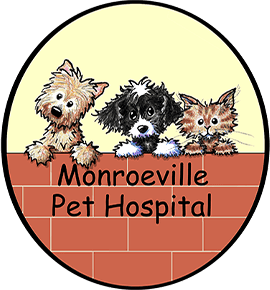Laser Therapy
Veterinary Laser Therapy in Monroeville
Laser therapy is the use of a specific wavelength of light (red and near infrared) to tissues of the body, which relieves inflammation and increases blood supply and nutritional elements to the affected tissues while reducing swelling and pain. Simply put, veterinary laser therapy provides relief from pain.
Laser therapy is a non-invasive, drug-free, surgery-free, pain-free treatment option. It is the only course of treatment that actually stimulates the body to heal from within.
Lasers produce a single wavelength (monochromatic) beam of light, collimated as it is generated. Laser light has the property of being coherent or in phase, which, in simple terms, means it is uniform and very orderly light. Class IV laser therapy uses a simple beam of light to penetrate tissues and produce positive tissue changes. It was FDA-approved in the USA in 2005 for use in humans and animals.
The Effects of Laser Therapy on Your Pet’s Body
The Cellular Effects of Laser Therapy
Our Services
The Benefits of Laser Therapy for Pets
Some conditions laser therapy can help relieve are:
- Osteoarthritis
- Hip dysplasia
- Muscle sprains
- Ligament Sprains
- Neck and back pain
- Wound healing
- Burns
- Otitis (ear infections)
- Lick granulomas
- Dermatological problems
- Cystitis (bladder inflammation)
- Insect Bites and stings
- Post-surgical pain relief
- Increased healing post-surgery
It has been shown again and again that pain impairs healing and, more importantly, is inhumane. We place utmost importance on your pets’ comfort and well-being. If your pet has limited mobility or suffers from chronic pain, laser therapy might help. Please ask our veterinary staff if laser therapy can help your pet.
Laser Therapy FAQ
The electromagnetic spectrum describes the entire range of radiation from gamma rays to radio waves. All forms of light, including laser light, emit radiation. As with visual light, excessive exposure to laser light can be detrimental. It is widely accepted that laser light poses the greatest risk to the eyes and, secondarily, to the skin, of living beings. Laser light is a non-ionizing form of radiation.
Radiation that has enough energy to move atoms in a molecule around or cause them to vibrate but not enough to remove electrons is referred to as non-ionizing radiation. Other examples of this kind of radiation are sound waves, visible light, and microwaves. Laser therapy is performed in relatively short time frames not to expose pets and operators for long periods. Appropriate eyewear is worn to prevent corneal damage, and the light emitted from the laser is always directed away from non-treated areas.
Infrared laser light interacts with the tissues on a cellular level, increasing metabolic activity within the cells and improving transport of nutrients across cell membrane. This initializes the increased production of cellular energy that leads to a cascade of beneficial effects, increasing cellular function of health.
As the photons of laser light penetrate deeply into the tissue, the energy available to individual cells increases. With more energy available, the cells can speed the process of absorbing nutrients and flushing out the waste products, thus accelerating the growth and healing of the tissue. Exposure to laser light helps repair tendons, ligaments, and muscles.
Laser light also stimulates the development of fibroblasts, the building of collagen, the essential protein required to replace old tissue or repair tissue injuries. This is why it helps treat tissue damage from cuts, scratches, burns, or surgery.
The treatment is entirely pain-free. Your pet may feel just the sensation of the probe moving against their fur coat or skin and/or a warm or tingling sensation over the treated area.
Each session usually takes 10-15 minutes to complete, depending on the number of areas treated. The therapy is performed by specially trained veterinary technicians. You are encouraged to stay with your pet during the treatment. Using a scanning, grid-like pattern, the laser operator uses hand-held probes to apply the laser energy to the targeted areas. The laser unit makes a beeping sound, lower than a normal conversation volume, to indicate laser operation and the transition between phases of continuous or pulsing energy.
Because the treatment is painless, anesthesia or sedation are unnecessary, thus avoiding the associated risk and expense. Pets may go home immediately after treatment.
